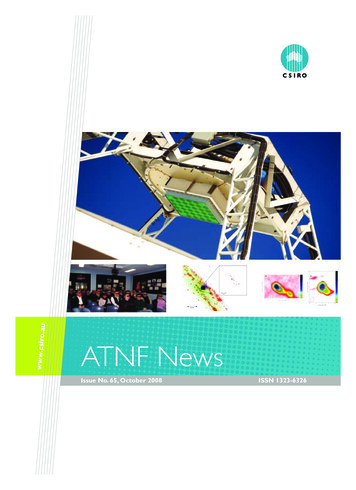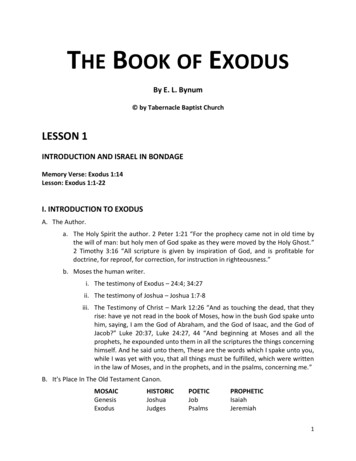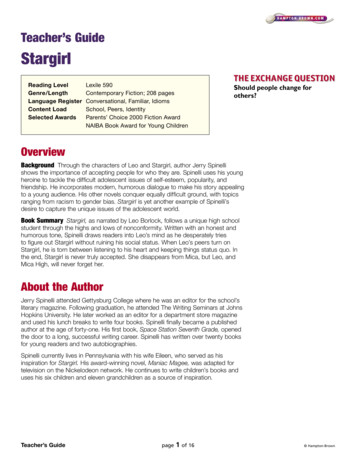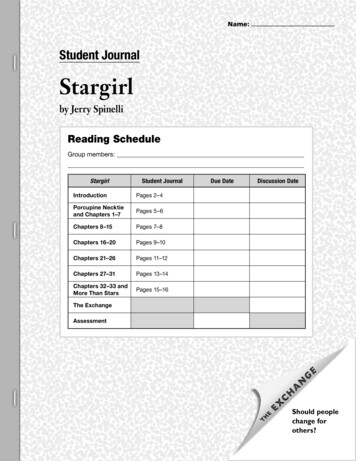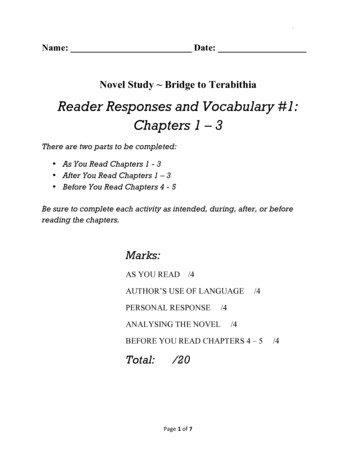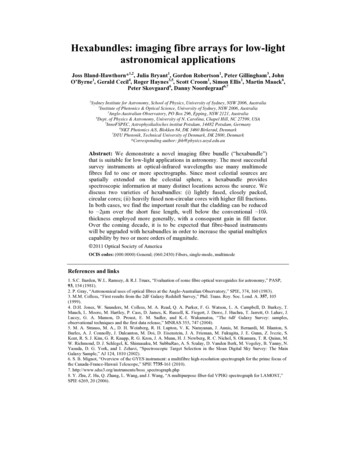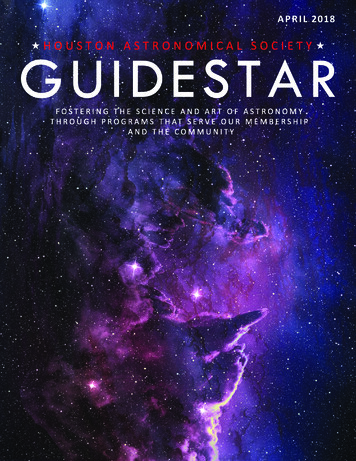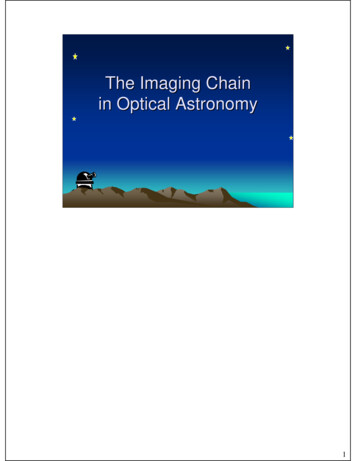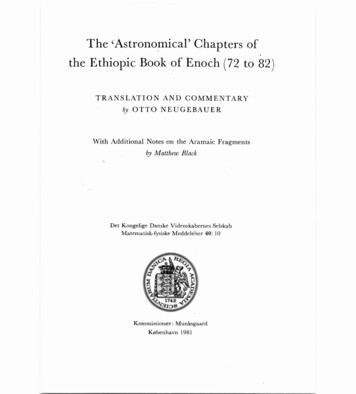
Transcription
The 'Astronomical' Chapters ofthe Ethiopic Book of Enoch (72 to 82)TRANSLATION AND COMMENTARYbyOTTONEUGEBAUERWith Additional Notes on the Aramaic Fragmentsby Matthew Black,Det Kongelige Danske Videnskabernes SelskabMatematisk-fysiske Meddelelser 40 : 10Kommissionær: MunksgaardKøbenhavn 1981
SummaryEthiopic literature has preserved the "Book of Enoch" which is, as we know, closely related to theJewish sect that is represented in the "Dead Sea Scrolls". Ten chapters of this work arc concerned withastronomical concepts of a rather primitive character (variation in the length of daylight, illuminationand rising amplitude of the moon, wind-directions, etc.), dominated by simple arithmetical patterns.The present paper gives a new translation of these chapters, followed by notes where the meaningof the text is not self-explanatory. An appendix, with additional notes, deals with related sourcematerial in the Qumran astronomical scrolls.OTTO NEUGEBAUERMATTHEW BLACKProfessorProfessorBrown University, Box 190040 Buchanan GardensProvidenceRhode Island 02912, USASt. AndrewsFife, ScotlandBibliographical AbbreviationsCharles, Enoch: R. H. Charles, The Book of Enoch, 2nd ed., Oxford 1912.Dillmann, Henoch: A. Dillmann, Das Buch Henoch, Leipzig 1853.Flemming, Henoch: J. Flemming, Das Buch Henoch, Leipzig 1902.Knibb, Enoch: M. A. Knibb, The Ethiopic Book of Enoch, 2 vols., Oxford 1978.Martin, Le Livre d'Henoch, F. Martin, Paris 1906.Milik, Enoch: J. T. Milik, The Books of Enoch, Oxford, 1976.Neugebauer, EAC: O. Neugebauer, Ethiopic Astronomy and Computus, Österr. Akad. d. Wiss.,Philos.-Hist. Kl., SB 347 (1979).P -Sm Payne Smith, Thesaurus Syricus, Oxford, 1879.'lh W NT 'theologisches Wörterbuch zum Neuen Testament. Det Kongelige Danske Videnskabernes Selskab 1981.Printed in Danmark by Bianco Lunos Bogtrykkeri A-S. ISSN 0023-3323. ISBN 87-7304-1173
340:10IntroductionIt has long been recognized that the astronomical chapters of the Book of Enochconstitute a composition of their own without much direct contact with theother parts of the treatise. This does not mean, however, that the astronomicalbook is unrelated to the rest of the Book of Enoch. On the contrar y , its contentsreflect faithfully, but in greater detail, the simple cosmologic concepts thatprevailed in the communities which produced the Enochian literature.I do not think, however, that one should consider the astronomical chaptersas a literary unit composed by one author who followed some stylistic reasoning.It seems obvious to me that the text, as we have it, consists of two major versions,both covering essentially the same material, to which are added several still morefragmentary pieces. What we have is not the work of one author (or "redactor")but a conglomerate of closely related versions made by generations of scribeswho assembled, to the best of their knowledge, the teaching current in theircommunity about the structure and the laws of the cosmos. It is also importantto note that purely calendaric rules on fasts and feasts are conspicuously absent,in marked contrast to the later Ethiopic "computus" of Judaic and Christianorigin.It is, of course, possible that there existed originally one treatise written tocodify the astronomical doctrines of a religious sect. Such a treatise would thenhave reached us only in several more or less modified versions, two of which arereflected in the present chapters 72 to 76 and 77 to 79,1 respectively. Fragmentsfrom additional versions are preserved in 79,2 to 80,1 while the description in 82of the angelical hierarchy of the stars evidently belongs to a quite different source.Furthermore it should be remembered that innumerable fragments of Enochian"astronomy" (concerning the variation of the length of daylight, the "gates,"the winds, etc.) are scattered all through the Ethiopian "computus"-treatises.The several chapters of our treatise are grouped around only a small numberof topics: solar year and lunar months, winds, the hierarchy of the stars, alwayshemmed in by a rigid schematism unrelated to reality. First the reader is toldabout the division of the "solar" year into four seasons of 30 30 31 days each.Then comes the variation of the length of daylight, based on a linear progressionwith extrema in the ratio 2:1. 'Then the lunar phases are also described by a linearpattern, assuming day 14 or da y 15, respectively, as full moon dates. 'The variable
40:104illumination of the moon is expressed either in terms of the moon's illuminatedarea (from 1 to 14 parts) or in relation to the sun's brightness, thus increasing from1/98 (i.e. 1/7 14) to 1/7 (at full moon). Finally lunar months, alternatingly fulland hollow, are related to the (schematic) solar year (but without any trace of acyclic adjustment) and to the rising and setting in the "gates" at the eastern,respectively western, horizon. Unrelated to these gates are the twelve gates forthe winds, four of which are beneficial, while eight bring discomfort and destruction. In contrast the stars are astronomically totally insignificant, being nothingbut a replica of the division of the solar year. Neither constellations nor the zodiacnor planets are ever mentioned. This remains the rule also for the Ethiopiccomputus until the Arab conquest.The search for time and place of origin of this primitive picture of the cosmicorder can hardly be expected to lead to definitive results. The use of 30-dayschematic months could have been inspired, e.g., by Babylonian arithmeticalschemes (of the type of"Mul-Apin"), or by the Egyptian calendar. But the numberand location of the epagomenal days was obviously chosen under the influenceof the Jewish seven-day week and has no parallel elsewhere. The linear patternfor the variation of the length of daylight as well as the ratio 2:1 of its extremasuggests an early Babylonian background. But there is no visible trace of thesophisticated Babylonian astronomy of the Persian or Seleucid-Parthian period.Dillmann's statement' that the astronomical part of the Book of Enoch isbased on concepts extant in the Old Testament is simply incorrect: the Enochyear is not an old semitic calendaric unit; the schematic alternation betweenhollow and full months is not a real lunar calendar, and there exists no linearscheme in the Old Testament for the length of daylight, or patterns for "gates",for winds, or for "thousands" of stars, related to the schematic year. 'The wholeEnochian astronomy is clearly an ad hoc construction and not the result of acommon semitic tradition.Summary of the Contents of Ch. 72 to 82First Version: 72 to 76 (with 74 probably being an intrusion)72,2-5: Gates and Windows; winds drive the chariot of the sun (cf. 73,2 and also 18,416-36: length of daylight, M:m 12:6; year of 4 . 91" 364 37: brightness and size of sun and moon (cf 73,3; 78,3,4)73,1-3: winds drive the chariot of the moon (cf. 72,5); brightness of sun and moon(cf. 72,37; 78,4)4-8: increase of the area of illumination and of brightness of the moon from day 11: Dillinann, Henoch,p. 220.
40:105to day 14 (incomplete); first visibility on the preceding day 30(i.e., after ahollow month)74,1-4: illumination of the moon during 15 days (i.e., for a full month)5--9: Gates and moon rise (incomplete)10-16: garbled description of an octaeteris75,1--7: stars ("thousands") and seasons (cf. 82,4-20)8,9: circumpolar stars76,1-13: the 12 gates of the winds and their qualities (cf. the short version 33 to 36)14: concluding words to Methuselah (cf. 79,1)Second Version : 77 to 79,177: Mythical geography78,1: two-division of the year (cf. 78,15,16; 79,4,5)2-5: lunar phases; size and brightness of sun and moon (cf. 72,33-37); Gates6-14: lunar visibility, waning moon; hollow and full months (cf. 73,4-8 and 74,1-4)15,16: two-division of the lunar year (cf. 78,1; 79,4,5)1 7 : visibility of the moon during night and daytime79,1: concluding words to Methuselah (cf. 76,14)Additional Fragments: 79,2 to 80,1; 82,4-20 (80,2 to 82,3 intrusion: apocalyptic)79,2,3: Gates and lunar phases4,5: two-division of the Enoch-year (cf. 78,1,15,16) and Enoch epact6,80,1: concluding speech of Uriel82,4-20: hierarchy of stars ("thousands"), their leaders during the Enoch year (cf.75,1) .It seemed tempting to utilize in this commentary to the astronomical chapters ofthe Book of Enoch the numerous parallels and variants found in the Ethiopic"computus" treatises.' Since, however, practically all of these texts are unpublishedand since only a detailed study could bring order and relative completeness tothis huge mass of material,' I have usually abstained from referring to such"secondary" sources, though they may well contain information more reliablethan the Book of Enoch in its present condition. I made good use, however, ofthe possibility of discussing my interpretations of the text with Professor EphraimIsaac at the Institute for Advanced Study in Princeton.In many ways every student of Enoch is indebted to Dillmann's pioneeringwork. When deviating from it in some technical details, however, I did not findit necessary always to quote Dillmann's translation and notes. In particular I didnot refer to all the cases where the mix-up between the "gates" in the horizonand the modern concepts of orbital motion in the ecliptic produced misleadingexplanations. The insight into its archaic primitiveness is the key to understandingEnochian "astronomy."2: Cf. for these texts my EAC.3: The majority of printed catalogues deals only in a very unreliable fashion with treatises of this type.
40:106Ch apter 721. Book on the Motion of the Luminaries of the Heaven, how each one of themstands in relation to their number, to their powers and their times, to theirnames and their origins and their months, as the holy angel Uriel, who is theirleader, showed to me when he was with me. And he showed to me their wholedescription as they are, and for the years of the World to eternity, until the creationwill be made anew to last forever.2. This is the first law of the luminaries: the light (called) Sun has its exitamong the gates of heaven in the east and it sets among the gates of heaven inthe west.3. And I saw six gates from which the sun rises and six gates where the sunsets; and (also) the moon rises and sets in these gates, as well as the leaders of thestars together with those which they lead. Six (gates) are in the east and six inthe west and all of them are arranged in sequence. And there are many windowsto the right and to the left of these gates.4. And first comes out the great light called Sun and its roundness is as theroundness of heaven and it is all filled with fire that illuminates and heats.5. And the chariot in which it rises the winds drive. And the sun goes downfrom the heaven and it turns toward north in order to travel toward the east;and it is guided in such a way that it enters in the (proper) gate and shines (again)in heaven.6. In this way (the sun) emerges in the first month from the great gate, thefourth of these six gates in the east.7. And in this fourth gate from which the sun emerges in the first month thereare twelve window-openings from which flames come forth when (these windows)are opened in their (proper) times.a. e. When the sun rises in the sky it rises from this fourth gate (during) 30days; and the sun sets exactly in this (fourth) gate in the west. 9 And in these daysthe day increases over the (preceding) day and the night decreases from the(preceding) night during 30 days. 10 'And on this (30th) day the day is two ninths,(i.e. two) "parts", longer than the night, the day being exactly 10 parts and thenight exactly 8 parts. "And the sun rises from the fourth gate and sets in thefourth (gate).b. (Then) the sun moves to the fifth gate in the east, for 30 days, and it risesfrom it and it sets in the fifth gate. ' 2 And then the day increases two parts andthe day amounts to eleven parts and the night decreases and amounts to seven parts.c. 13 And (the sun) returns to the east and enters the sixth gate and it risesand sets in the sixth gate (during) 31 days according to its (the gate's) characteristics(for the season). 14 And during these days the day increases over the night (until)the day is twice (as long as) the night, such that the day amounts to twelve parts
40:107and the night decreases and amounts to s ix parts. 'Then the sun sets out toshorten the day and to lengthen the night.d. And when the sun returns to the east it enters the sixth gate and it risesfrom it and it sets (in it during) 30 days. 16 And when the 30 days are completedthe day has decreased exactly one part and the day is eleven parts and the nightis seven parts. 17 And then the sun leaves this sixth gate in the west ande. travels toward east to rise in the fifth gate (during) 30 days and it sets alsoin the west in the fifth gate. ' And on this day the day has decreased two partsand the day is ten parts and the night is eight parts. 19. And the sun rises from thefifth gate and it sets in the fifth gate in the west.f. (And then) it rises in the fourth (during) 31 days (according to) its (thegate's) characteristics (for the season), and it sets in the west. 20 , On this day theday equals the night and they are the same and the night is nine parts and theday is nine parts. 21 .And the sun rises from this (fourth) gate and it sets in the west.g. And (then) it returns to the east and it rises from the third gate (during)30 days and it sets in the west in the third gate. 'And on these days the nightincreases over the day and the night increases over the (preceding) night and theday decreases from the (preceding) day until 30 days and the night is exactly23. And the sun rises from this third gate and itten parts and the day eight parts.sets in the west in the third gate.h. And (then) it returns toward the east and the sun rises (during) 30 days inthe second gate in the east and it sets also in the second gate in the western sky.24 And on this day the night is eleven parts and the day seven parts. 25 And inthese days the sun rises from this second gate and sets in the west (also) in thesecond gate.i. And (then) it returns to the east to the first gate (during) 31 days and it26(also) sets in the first gate in the western sky. And on this day the night hasincreased to become twice (the length of) the day and the night is exactly 12 partsand the day is 6 parts.k. 27 [And the sun has (thus) completed its appearances (in all gates) andthen returns to these (same) appearances and it rises (again) in all its gates (during)30 days and it sets opposite to them in the west.]1. 28. And (during) these days the night has decreased by a ninth part (of itsmean length), that is by one part; and the night consists of eleven parts and theday of seven parts.m. 29 And the sun returns and enters the second gate in the east [and it returnsto these appearances] during 30 days, rising and setting (in the second gate).30 And in these days the night decreases in its length and the night is ten partsand the day eight parts. 31 'And in these days the sun rises from the second gateand sets in the west.
coTABLE 1*Q rises and sets in G, for 30"; d increases, n decreases. Finally d n } 2, thus d 10, n 8. Sunrise and sunset in G4.I' Q returns to E, in G ; for 30'; d increases by 2 to d 1 1, n decreases to n 7. (Q) returns to E, enters G 6 ; rises and sets in G s for 31", as appropriate: ci increases to d 2n, thus d 12, n 6.0 begins to shorten d and lengthen n:dQ returns to E, enters G 6 ; rises and sets in it for 30". After completion of these 30", d has decreased by 1, thus d 11, n 7.Q leaves GR in the W andctravels to E, to rise and to set in G 5 for 30". Finally d has decreased by 2, thus d 10, n 8. Sunrise and sunset in G,.f0rises in G4 for 31 , as appropriate, sets in W. (Finally) d n, thus n 9, d 9. Sunrise and sunset in G4.Q returns to E,rises and sets in G 3 for 30". Now n increases over d; n increases, d decreases, until (after) 30" n 10, d 8.Sunrise and sunset in the W in G3.1 ' Q returns to E,Q returns to E,k'rises in G2 for 30", sets in the W in G 2 . Finally n 11, d 7. Sunrise and sunset in the W in G2.[rises and] sets in the NV in G, for 31". Finall y n lias increased to n 2d, thus n 12, d 6.{Q completed its appearances (in all gates), now returns to these appearances, rising in all gates for 30" and sets in the W.}[0rises in Gi for 30"Finally] n has decreased by 1, thus n 11, d 7.1 Q returns to E, [rising] in G 2 returns to appearances, rising and setting for 30 ; n decreases, thus (finally) n 10, d 8. Sunrise and sunsetin the W in G2."Q returns to E, rising in G 3 for 31 , setting in the W; n decreases to 9, thus d 9 and n d. {The year is 364 long.}*Q. sun, G.gate (its number as subscript), E/W1' . East ; West, d . day, n . night { } . intrusion
940:10n. And (then) it returns to the east and it rises in the third gate (during)31 days and it sets in the western sky. 32 And in these days the night decreasesand it is 9 parts and the day is 9 parts and the night equals the day. [And the yearis exactly 364 days (long)].33. And the length of the day and the night and the shorteness of day andnight vary with the circuit of the sun,34. because its course becomes longer day after day or shorter night afternight.35. And this is the rule for the circuit of the sun, when it returns (to the east)and rises (again). This great luminary is called "sun" for all eternity.36. And what rises is the great luminary and it is named according to itsappearance as the Lord has commanded.37. And it rises and similarly it sets and it does not diminish (in brightness)and it does not rest, but travels day and night. And its light is seven times asbright as the (light of the full) moon but with respect to their size the two areequal.Notes to Chapter 72. Sun and MoonThe composition of this chapter is very simple: its core is formed by twelvestrictly parallel verses that describe the variation of the length of daylight andnight during the year. To this tabulation is added a general introduction (2 to 7)about the six "gates" on the eastern and western horizon where the sun rises andsets. Similarly the tabulation is followed by some general remarks (33 to 37)about the sun and its role in the universe.This structure of the chapter has been obscured by dividing the text intotwenty-five verses unrelated to the original tabulation. I have therefore compileda table (opposite) which shows the original pattern. Needless to say, there are manysmall variations from sentence to sentence. A serious disturbance occurred inverse 28 where a gloss (27) intruded into the text (with a repercussion still visiblein 29). But Table I makes it easy to restore the basic scheme for each month:"The sun returns (from the preceding gate) to the east and enters the nextgate in which it rises — and sets in the west — for 30 (or 31) days. During thattime the days increase/decrease and the nights decrease/increase such thatthe day becomes . (parts), the night . (parts). Sunrise — and sunset in thewest — takes place in this gate".Twelve such sentences are the exact equivalent of our Table II or of the graphFig. 1. Similar verbal presentations of tabular material are not only foundfrequently in Ethiopic computus texts but also in Aramaic fragments (Milik,
40:1010TABLE IImonth 1 in gate 4 during 30 days, ending in 10 r of daylight, 8 9 of 711913161210130711112308101233199Enoch, pp. 278-281). I have no doubt that the same genesis underlies also thenext chapter.72.1. Preamble, giving a summary of topics concerning the celestial luminaries. The expression hezabihomu, literally "their tribes, populations", obviouslyrefers to the hierarchical grouping of the stars. Similarly Seltanomu means "theirpowers", exercised by the stars over the division of the year, the seasons and theepagomenal days. Cf. for all these influences 75,1-7 and 82,4-20.72,2,3. In the course of the year sun and moon rise and set in six "gates" onthe eastern, respectively western, horizon. To the right and to the left of thesegates are "windows", presumably for the stars (whereas in 36,2,3 "small gates"are assigned' to them). It should be noted that "right" and "left" are not the sameas "south" and "north" since these associations are reversed with the change ofdirection of the observer.Verse 3. "Arranged in sequence" probably refers to the numbering of thegates from one to six or from south to north.72,4. The "roundness" (kebabu) of the sun corresponds to the roundness ofthe heavenly cupola. Neither "Umkreis" (Dillmann) nor "disc" (Knibb) aresuitable descriptions of the sky.72,5. Here we are told that the chariot of the sun (and of the moon, cf. 72,2)is blown by winds, and that the sun, after setting in the west, returns via the northto the east. Independent of this motion of the luminaries is the (daily) rotation ofthe heaven, i.e. of the stars, which is also caused by winds (18,4). A slightly different picture is found in 41,5 where sun and moon are said to come out from, andreturn to, "chambers" (mazdgebt). Similar differences are recognizable for thestars: "windows" in 72,2,3, "gates" in 36,2,3.
1140:10Fig. 1.intursommorenomNrodrourhommAmium, tanuminiN 2,6 to 32. The essential content of these verses is summarized in Table IIand in the graph of Fig. 1. Note that the linear pattern for the length of daylightand night ignores the epagomenal days (as is admitted in 75,1).The variation of the length of daylight and night during the solar year is heredescribed by a numerical sequence that alternates, with constant difference,between a maximumM and a minimum m. If one chooses the simplest increment,M m 6. Ifone furthermore assumes that M 2m, then one finds finally m 6 P , M 12Pi.e. if one makes the monthly difference "1 part" (p), then one has(and always daylight night 18 P ). This is exactly what we have in our text.The use of such an alternating sequence (known as "linear zigzag function")suggests a Babylonian origin, since functions of this type play a fundamental rolein Babylonian astronomy. For the length of daylight we find in cuneiform textstwo ratios: oneM:m Apin")2:1. In the first case the units of time are "large hours" (i.e. 4 ofM:m 3:2, the other (in earlier texts, e.g. in the series "Mul-our hours), in the second case we deal with "manas", i.e. weights of water, outflowing from a cylindrical water clock.'In our texts the "parts" are never connected with any meteorological unit,neither hours, nor weights or volumes. Hence borrowing from Mesopotamia4: Cf. Neugebauer, The Water Clock in Babylonian Astronomy, Is is 37 (1947), pp. 37-43.
40:1012remains only a possibility, though supported by another (slightly conjectural)feature, an 18-division of the day (counted in manas) in Mul-Apin.5Of course a borrowing from comparatively early Babylonian material cannotbe used as a chronological criterion for the time of composition of the astronomicalsection of the Book of Enoch. Methods of this kind have a life-span of manycenturies and easily survive the development of more advanced methods.72,6 to 11. In month 1 the sun emerges from gate 4 and the length of daylightincreases during this month from 9 P to lO p . Note that this implies that the yearbegins at the vernal equinox (as in Babylonia) whereas the Ethiopic calendarfollows the Alexandrian year that begins with the month Thoth, roughly September.Why is gate 4 called "large"? Dillmann 6 thinks of a comparison with the 12windows which eject flames (72,7). Are other gates not provided with suchwindows?Verse 11. After 30 days the sun returns (yegabe') from gate 4 in the west (viathe north) to gate 5 in the east.72,13 and 19. The translation of te'emerta zi'ahå as "its sign" is misleadingsince it could be taken as a reference to zodiacal signs' (which do not exist inEnoch's astronomy). The purpose of this remark, however, is to explain that 31days of the sun's risings in the same gate is indicative for the position of the equinoxes and solstices. The Greek equivalent of te'emert is O lpCiOv used in a technical sense,' in particular in relation to meteorological and calendaric dates*nlonpaivctv). 9 Hence we may say that the rising of the sun in a specific gate is"indicative" or "characteristic" for the seasons. Cf. also 75,6 and 82,16 and 19.Verse 19. As Fig. 1 (p. 11) shows, the autumnal equinox occurs when the sunrises at the beginning of gate 3 in month 7.72,27. Dillmann rendered 'ar'estihu by "Bahnabschnitte" (hence Knibb:"division of journey" — instead of "orbital segments"). It seems to me, however,that no reference to the sun's "orbit" 10 — at any rate a much too modern concept— is intended. In my opinion what is meant is simply the appearances (literallythe "heads", the "beginnings") in the consecutive gates. This interpretation issupported by a variant in 'rand 9: 'ar'ayåhu, indicating something like "appearances". Cf. also next section.5: This connection between Mul-Apin and the Book of Enoch was suggested many years ago byA.J. Sachs (cf. Neugebauer, I.c note 4, p. 40).6: Dillmann, Henoch, p. 222.7: So expressly by Charles.8: Cf. e.g., also Matth. 16,3 arl icia TWV KatpCJV "the signs of the time".9: Cf. e.g., Ptolemy's work måaelç åriNavtw daTépwv Kai auvaywyrl rnarlpaaiWV (Operaminora, pp. 2-67). Cf. also RE Suppl. 7 col. 176-198 [Rehm].10: Not to ask: the daily orbit? the yearly orbit? what are Bahnabschnitte"?
1340:1072,33 to 35. The variability of the length of daylight and night is caused by thevariability of the sun's positions in the gates (cf. verse 27), i.e. by the changingrising amplitude, as is indeed the case.A number "60" (of risings and settings?) in verse 35 is omitted in severalmanuscripts (among them Tånå 9). This seems to be the better version.72,37. The sun's brightness never changes (in contrast to the moon) and it issevenfold the moon's greatest brightness" (cf. 73,3 and 78,4). Their apparentsizes, however, are equal (cf. 78,3). 12Ch apter 731. And after the rule (concerning the sun) I saw another rule about the smallerluminary, called Moon.2. And its roundness is as the roundness of heaven and the chariot on whichit travels is driven by winds; and light is given to it in measure.3. And each month its place of rising and of setting varies (through all gates)but its days are as the days of the sun. And when its light is evenly spread (overits disc) then it amounts to one seventh of the light of the sun.4. And thus (the lunar month) begins, when (the moon) itself moves away(from the sun) toward east on the 30th day, and (when) on this day it becomesvisible it is for you the beginning of the (lunar) month on the thirtieth day, (whenthe moon is setting) together with the sun in the gate from which the sun rises,' (but)at a distance (from the sun) of half of a seventh part.And its whole disc is empty (i.e.) without light, excepting its seventh part ofa fourteenth part (i.e. 1/98) of the light (of the sun).6. And on (this) day (the moon) takes on a seventh part of one half (i.e. 1/14)of its light, and (thus) its light is the seventh of a seventh part and one half of it(i.e. 1/98 of the light of the sun).7. (The moon) sets with the sun and when the sun rises, the moon rises withit and it takes on one half part (of 1/7) of its light. And in this night, at the beginningof the (lunar) day, which is the first day of the month, the moon sets with the sun,and it is dark in this night. — A seventh of a seventh part and one half.8. And the moon rises and comes out on this day with exactly the seventh part(of its total light) and recedes from the rising of the sun and it (the moon) isII : Dillmann (Henoch p. 226) suggests a derivation of this ratio from Isaiah 30.26. This passage(and similarly Enoch 91,16), however, does not compare the sun with the moon but dealswith some future events in the universe.12: This is very nearly correct, as is common knowlege in ancient astronomy (based on evidencefrom solar eclipses).
40:1014illuminated during the remaining (part) of its day a sixth (?) and a seventh part(of the light of the sun).,Notes to Chapter73. The Moon's Variable IlluminationThe original arrangement in this chapter was probably similar to the arrangementin the preceding chapter: a central tabulation preceded (and perhaps also followed)by general remarks. In the extant version, however, only the introduction ispreserved (verses 1 to 3) while the tabulation breaks off after day 2. No doubtoriginally all days until full moon (day 14) had been listed. Instead we find nowa disorganized chapter(74) whichobviously does not belong to the originalcomposition.73,1 to 3. The moon's chariot is driven by winds (cf.72,5) and the roundnessof the moon is as the roundness of the heavens. 13 Light is given to the moon (fromthe sun) and produces at full moon one-seventh of the sun's brightness (cf. 72,37and 78,4). The rising and setting points of the moon change rapidly, but thenumber of "days" in a lunar calendar is the same as the corresponding numberof solar days (73,3); for example, day 14 has the same distance from day 1 in alunar u alcndar as a solar day 14 from solar day 1, in spite of the variability of themoments of moon-rise and moon-set in relation to sun-set. — For 73,2 cf. also 78,4.73,4 to 8. In these verses we have a fragmentary description of a linear schemefor the increasing illumination of the moon during the first half of the lunarmonth. This increase is expressed in two scales: first, in absolute terms from 1 to 14" (hence proportional to the illuminated area), 14 and, secondly, in terms ofsolar brightness, hence increasing from 1/141/7 1/98 on the first day to 1/7at full moon (cf. 73,3). Our text represents only a fragment of this scheme, whichconcerns t
4,5: two-division of the Enoch-year (cf. 78,1,15,16) and Enoch epact 6,80,1: concluding speech of Uriel 82,4-20: hierarchy of stars ("thousands"), their leaders during the Enoch year (cf. 75,1) . It seemed tempting to utilize in this commentary to the astronomical chapters of the Book of Enoch the numerous parallels and variants found in the .


